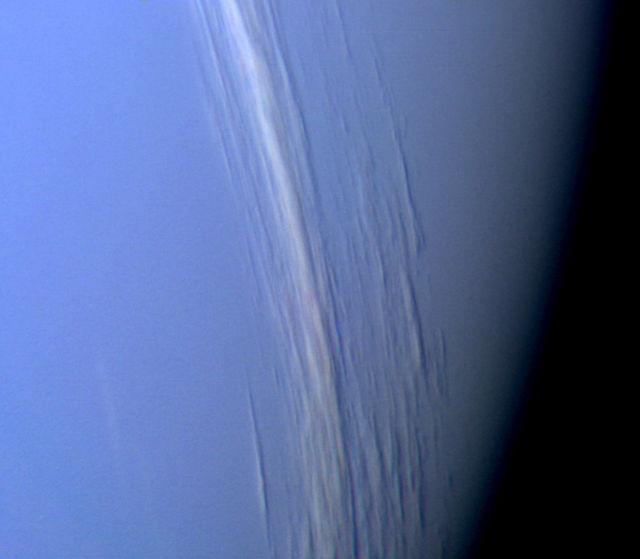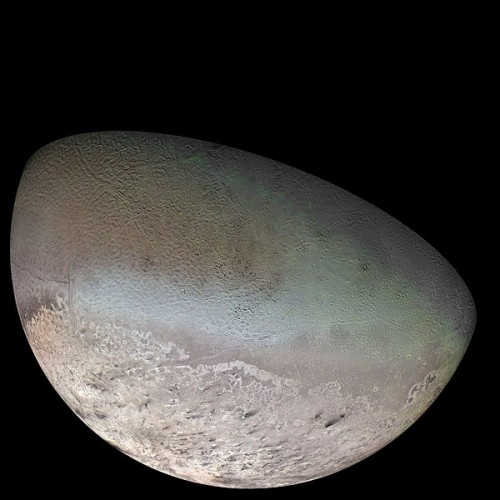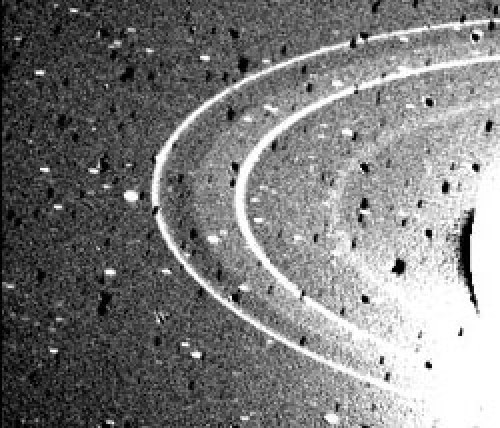
Twenty-five years ago, this week, humanity braced itself for its last, first-time, close-up glimpse of a new planet in the 20th century. NASA’s Voyager 2 spacecraft, launched in August 1977, had already conducted a breathtaking exploration of Jupiter and Saturn—together with its twin, Voyager 1—and had undertaken our species’ first visit to Uranus. In readiness for the Uranus and Neptune rendezvous, a conference in Pasadena, Calif., in February 1984, allowed scientists to look at what was known about the two mysterious planets and identify a comprehensive series of observations about them. Although a reasonable amount of valuable data existed about Neptune, the enormous quantity of new information which would flow back to Earth in August 1989 enriched our understanding of this strange, distant world. As described in yesterday’s AmericaSpace history article, planning for the encounter had already required major enhancements in the worldwide deep-space tracking network.
Prior to the discovery of ring material (initially thought to be incomplete ring “arcs,” partially encircling Neptune) in the early 1980s, the Voyager team planned to pass very close over the planet’s north polar region to establish the proper conditions for a 6,200-mile (10,000-km) flyby of its large moon, Triton. However, when ground-based astronomers detected evidence of ring material, the possibility of incurring damage to the spacecraft led mission planners to increase the polar range, and the Triton flyby was opened to 25,000 miles (40,000 km). Passing through the Neptunian system would be nothing less than a white-knuckle ride for Voyager 2, skimming a mere 3,000 miles (4,900 km) over the planet’s cloud tops and executing a whistle-stop tour of Triton.
Perversely, it would actually be the least risky of Voyager 2’s four planetary encounters, simply because the spacecraft had no more such visits ahead of it. “It gave us the freedom to choose a flyby geometry that was best for the studies of Neptune and Triton,” said Dr. Ellis Miner of the Jet Propulsion Laboratory (JPL) in Pasadena, Calif., “without having to worry about where the spacecraft would be going thereafter.” An extended mission to tiny Pluto had long since been ruled out, because it no longer lay on either Voyager’s flight path and too much propellant would be required to reach it. “Voyager 1’s trajectory after the Saturn encounter remains well above the ecliptic plane in which essentially all the planets orbit,” Miner explained. “As we were approaching Saturn with Voyager 2, we could have gone directly to Pluto or we could engineer encounters of Uranus and Neptune. We didn’t even know that Pluto had a moon at that time, but it wouldn’t have made any difference. The combination of Uranus and Neptune were deemed far more important than a single flyby of Pluto. If we were making that choice today, I believe the choice would be the same.” However, although the mission planners had a relatively free hand in planning Voyager 2’s trajectory through the Neptunian system, they were keen to ensure the safety of the spacecraft, for NASA intended to use it for another two to three decades for an extended Voyager Interstellar Mission (VIM) to search for the edge of the Solar System.

Top of the list of priorities at Neptune was getting as close as possible to the planet and flying sufficiently near to Triton, in order to acquire map-quality images of its frozen surface. Yet the question of the nature of the planet’s rings remained unanswered. Were they “complete” rings or merely incomplete “ring-arcs,” perhaps “shepherded” in orbit around Neptune by tiny, unseen moons? NASA wanted to avoid contact with any ring material, no matter how small or tenuous, but there remained an alarming possibility that Neptune may possess extended atmospheric gases which could pose additional danger.
Matters were compounded still more by scientists’ desire to collect occultation data for both Neptune and Triton. This would be done by passing the spacecraft’s radio signal through their atmospheres as they passed in front of Earth and the Sun on two occasions apiece. Each occultation was expected to permit the gathering of temperature and pressure readings, as well as ascertaining the ultraviolet “signatures” of gases emitted into space. The result would be an improved level of understanding of the internal chemical dynamics of both Neptune and Triton. In order to conduct all four occultations, and pass close enough to both worlds for detailed imaging, trajectory planners adopted a risky maneuver. After hurtling over the planet’s north pole, Voyager 2 would plunge “southward,” behind Neptune, pass within 25,000 miles (40,000 km) of Triton about five hours later, and ultimately depart the Solar System forever at southern mid-latitudes. It was an audacious plan which promised substantial scientific rewards if it worked. On the other hand, if it failed, it could result in the total loss of Voyager 2.
Even after adopting this trajectory, there remained serious concerns that a closer flyby of Triton was needed in order to acquire sufficiently high-resolution images. Moreover, such a move would also improve the chances of success for the pair of Earth occultations, which could be timed to occur directly over the Canberra ground station in Australia. In response, NASA decided to postpone Voyager 2’s arrival at Neptune until early on 25 August 1989, which would hopefully carry the spacecraft closer to Triton. Consequently, on St. Valentine’s Day in 1986, three weeks after leaving Uranus, the first of six trajectory correction maneuvers were executed to chart a course for Neptune. Only four of these were ultimately required, thanks to the better-than-expected accuracy of the earlier ones, together with more precise observations from Earth, which gave trajectory planners a clearer idea of where the suspected ring material lay.
Navigating a path to Neptune was far more complex than for Jupiter, Saturn, and Uranus. For each journey, the Voyagers utilized optical navigation techniques to reach their targets, acquiring long-exposure images of each planet’s moons, against a known “star field,” which provided a determination of the exact position of each object. However, whereas Uranus was known to possess at least five moons before 1986, and Jupiter and Saturn both had in excess of a dozen apiece, Neptune—at the time—was thought to have only two. The smaller of these, Nereid, discovered by astronomer Gerard Kuiper in 1949, is a maverick in a highly eccentric orbit and takes 360 days to orbit its host. Triton, on the other hand, occupies a more stable, relatively circular, though retrograde, orbit, circling Neptune every six days, which made it more useful as a navigational tool.

With just one reliable point of celestial reference to navigate a journey of a billion miles (1.6 billion km) beyond Uranus seemed, at best, risky. However, mission planners were keenly aware that more moons would likely be found as Voyager 2 drew closer. As a result, optical navigation details were programmed into the spacecraft’s computer, but omitted to specify their targets, which would be updated at short notice when new moons were discovered and their parameters accurately plotted.
Fortunately, the discovery of six new moons came thick and fast in the summer of 1989, leading to a seven-minute-long trajectory correction firing on 2 August to precisely direct Voyager 2 toward Neptune. Ironically, one of these new moons—later named “Larissa”—had actually been seen from Earth during an occultation event in 1981, but could not be confirmed in more than one sighting. All six new moons were irregular, like battered potatoes, dark as soot, and were confined to the region around Neptune’s equator.
In addition to observing the moons, Voyager 2 had begun observing the planet itself for some considerable time. In May 1988, from a distance of 425 million miles (684 million km), the spacecraft’s images were already of better quality than anything acquired from Earth, resolving Triton for the first time as a pale reddish smudge. However, the 12 weeks from June to September 1989 would produce the most spectacular observations of a planetary system like no other: a beautiful, sky-blue world, four times the size of Earth, with a misleadingly calm appearance, beyond whose roiling clouds lurked violent storms, bizarre weather, and some of the fastest winds ever seen in the Solar System.
This series of articles commemorating the 25th anniversary of Voyager 2’s encounter with Neptune will continue next weekend.
Want to keep up-to-date with all things space? Be sure to “Like” AmericaSpace on Facebook and follow us on Twitter: @AmericaSpace




Ben, I never cease to be amazed at how you are able to glean such in-depth, fascinating, little-known information about events that happened decades ago. Each article you write is a present with delightful surprises within. You research skills are of such a high level of sophistication that if I didn’t know better, I’d swear that you had a time machine (a Tardis perhaps?) at your disposal. Thank you for the great work Ben!